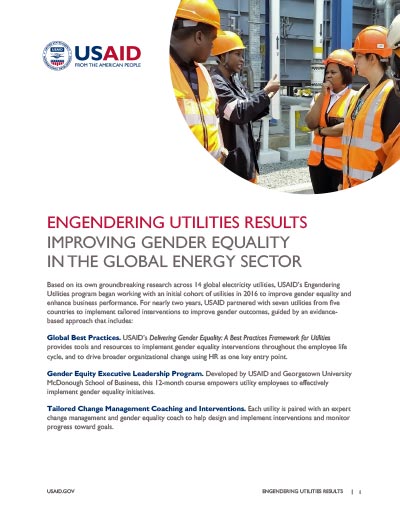- Energy Home
- How We Work
- Programs & Initiatives
- EmPOWERing Women and Girls
- Competitive Energy Procurement
- Toolkits
- Monitoring & Evaluation
- Resources
- Stories
Speeches Shim
Improving Gender Equality in the Global Energy Sector
USAID partnered with seven utilities in 2016 to improve gender equality and enhance business performance. All seven utilities significantly expanded their talent pools for recruitment and diversified their organizations.
Based on its own groundbreaking research across 14 global electricity utilities, USAID’s Engendering Utilities program began working with an initial cohort of utilities in 2016 to improve gender equality and enhance business performance. For nearly two years, USAID partnered with seven utilities from five countries to implement tailored interventions to improve gender outcomes, guided by an evidence-based approach that includes:
- Global best practices. USAID’s Delivering Gender Equality: A Best Practices Framework for Male-Dominated Industries provides tools and resources to implement gender equality interventions throughout the employee life cycle.
- Gender Equity Executive Leadership Program. Developed by USAID and Georgetown University McDonough School of Business, this 12-month course empowers utility employees to effectively implement gender equality initiatives.
- Tailored Change Management Coaching and Interventions. Each utility is paired with an expert change management and gender equality coach to help design and implement interventions and monitor progress toward goals.
Impact
All seven Engendering Utilities partners significantly expanded their talent pools for recruitment and diversified their organizations. All utilities have:
- Increased the number of female employees
- Drafted or adopted Equal Employment Opportunity (EEO) statements
- Conducted pay gap analyses and are implementing plans to address gaps that were identified
- Reviewed Human Resources policies against global standards to determine gender equity gaps
- Gathered sex-disaggregated employment and employee satisfaction data, in some cases for the first time, for use in decision-making
- Adopted new policies to address gender equity, which are being implemented and enforced at all levels of the company
- Moved to behavior-based interviewing techniques to reduce bias in hiring processes
Each utility partner has implemented tailored interventions designed to address their gender equality goals.


Comment
Make a general inquiry or suggest an improvement.